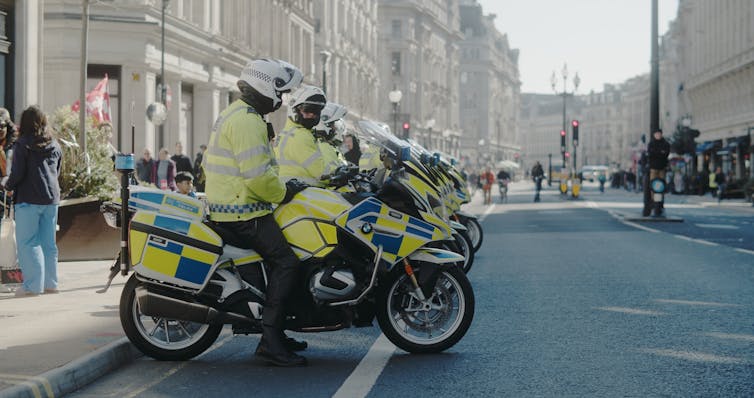Angus Nurse, Nottingham Trent University
Louise Casey’s review of the standards of behaviour and internal culture at the Metropolitan police makes for uncomfortable reading. It was commissioned following the kidnap, rape and murder of Sarah Everard by Wayne Couzens, who was a serving Met officer at the time.
Casey highlights the prevalence of sexism and homophobia. Crucially, in considering police culture she draws different conclusions on the existence of institutional racism than the position taken in 2021 by Boris Johnson’s government on race.
Institutional racism is defined as racial discrimination in process, attitude and behaviour. It results from prejudice, ignorance, thoughtlessness or racist stereotyping. And it adversely affects people from minority ethnic communities.
In 1999, already, the Macpherson report found the force guilty of institutional racism. The recent cases of Met officers accused of racially profiling the athletes Bianca Williams and Ricardo dos Santos and the two Met officers dismissed for sharing photographs and making inappropriate comments about Bibaa Henry and Nicole Smallman, the sisters murdered in 2020, have highlighted, however, how little has been done about it.
Many commentators have grave concerns about how black communities in the UK are disproportionately and unfairly policed. In 2020 the House of Lords reported on the disproportionate use of stop and search against black Londoners. Research shows that people from black and mixed ethnic groups have lower trust and confidence in the Met.
The challenge for the force, then, is whether it will accept this institutional failure. In figuring out how to deal with it, it should, among other things, examine how complaints are dealt with, how staff members are able to raise issues themselves, and how performance monitoring uncovers problems.

RobertoBarcellona/Shutterstock
The scale of the task
Casey does not simply highlight the problems with how black citizens are policed, and the crimes perpetrated against them dealt with. She says the Met is unrepresentative of Londoners, noting that “Met officers are 82% white and 71% male” and that “the Met does not look like the majority of Londoners”.
She acknowledges that the force has improved the ethnic diversity of its workforce. However, she states that black communities in London are “under-protected –- disproportionately the victims of homicides and domestic abuse; and over-policed –- facing disproportionate use of stop and search and use of force by the Met”.
The Met’s response to scandals, the review says, often involves “playing them down, denial, obfuscation, and digging in to defend officers without seeming to understand their wider significance”. Casey also points to what many regard as a “hostile culture” within the force, with evidence of systematic racial bias against black, Asian, and ethnic minority staff.
Mark Rowley, the Met commissioner, responded to Casey’s findings acknowledging that the racism, among other ills, is systemic. However, he rejected the term “institutional”. To his mind, it is a political term, unhelpful because it is ill-defined. Instead, he emphasised the need to root out “toxic individuals”.
Individual offenders seeking to justify their actions will sometimes use what sociologists and criminologists call “neutralisation techniques” to minimise their guilt. Organisations also routinely deploy them, to underplay the seriousness of the allegations made against them.
This is because denial deflects from the need to act. Appealing to higher loyalties protects the profession or the organisation by asserting its value.
When organisations are faced with accusations of racism, the institutional response often emphasises that the fault lies with individual rotten apples, as opposed to the barrel itself. The institution thus avoids facing up to the reality of the situation and embracing meaningful and effective change, even when senior leadership displays willingness to do so.
Conversely, responses that are system led and process driven but ineffective are just as fruitless. Casey says the Met has often responded to problems by effectively just ticking boxes. A complaints system or procedure might provide a mechanism that allows people (or groups) to raise complaints. But the process (that is, the response) is taken up with logging the level and number of complaints and defending an organisational position.
Instead, organisations need to take their cues from what research and data tell them about the existence of institutional racism and discrimination. They need to identify the nature of issues and then implement thorough organisational changes.
When it comes to identifying misconduct, Casey suggests introducing a new misconduct system and overhauling the vetting processes for new recruits and for specialist units. She also recommends that the commissioner be granted greater powers to better enforce the misconduct standards and remove officers whose conduct falls short of the required standards.
On race, however, her recommendations fall short. The Macpherson report had 70 recommendations. They included implementing a code of conduct that would “ensure that racist words or acts proved to have been spoken or done by police officers should lead to disciplinary proceedings”.
And yet, 24 years on from that report, the Casey review is still recommending training and codes of practice. This suggests that Macpherson’s recommendations were not efficiently implemented.
Like many large institutions, the Met risks remaining in denial about the scale of its racism problem. It has failed to appropriately challenge discriminatory attitudes and behaviour. Inaction or ineffective action will only further enable those who hold racist attitudes.
Angus Nurse, Head of Criminology and Criminal Justice, Nottingham Trent University
This article is republished from The Conversation under a Creative Commons license. Read the original article.

